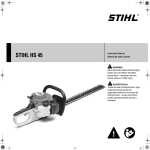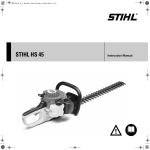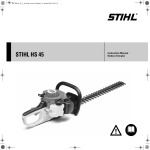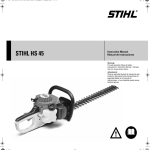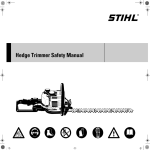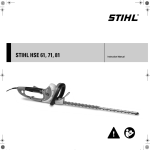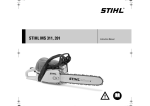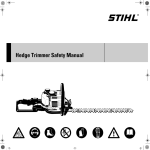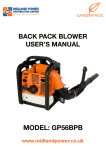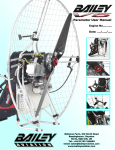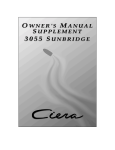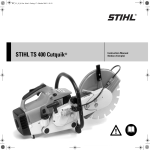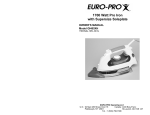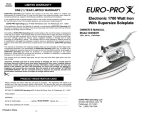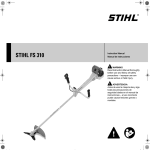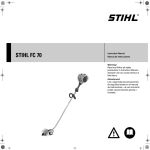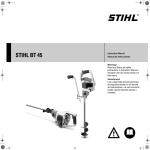Download Operator`s Manual
Transcript
{
STIHL HS 45
Instruction Manual
English
© ANDREAS STIHL AG & Co. KG, 2014
0458-253-0121-B. VA7.L14.
0000006574_006_GB
Printed on chlorine-free paper
Printing inks contain vegetable oils, paper can be recycled.
Original Instruction Manual
Contents
Guide to Using this Manual
Safety Precautions and Working
Techniques
Using the Unit
Fuel
Fueling
Starting / Stopping the Engine
Operating Instructions
Cleaning the Air Filter
Adjusting the Carburetor
Spark Plug
Engine Running Behavior
Lubricating the Gearbox
Rewind Starter
Storing the Machine
Sharpening Instructions
Inspections and Maintenance by
Dealer
Maintenance and Care
Minimize Wear and Avoid Damage
Main Parts
Specifications
Maintenance and Repairs
Disposal
EC Declaration of Conformity
{
HS 45
2
2
7
8
10
10
12
12
13
14
15
15
15
16
16
16
17
19
20
21
22
22
22
Dear Customer,
Thank you for choosing a quality
engineered STIHL product.
It has been built using modern
production techniques and
comprehensive quality assurance.
Every effort has been made to ensure
your satisfaction and troublefree use of
the product.
Please contact your dealer or our sales
company if you have any queries
concerning this product.
Your
Dr. Nikolas Stihl
This instruction manual is protected by copyright. All rights reserved, especially the rights to reproduce, translate and process
with electronic systems.
1
English
Guide to Using this Manual
NOTICE
Caution where there is a risk of
damaging the machine or its individual
components.
Pictograms
The meanings of the pictograms
attached to the machine are explained in
this manual.
Depending on the model concerned, the
following pictograms may be attached to
your machine.
Fuel tank; fuel mixture of
gasoline and engine oil
Operate manual fuel
pump
Engineering improvements
STIHL's philosophy is to continually
improve all of its products. For this
reason we may modify the design,
engineering and appearance of our
products periodically.
Therefore, some changes, modifications
and improvements may not be covered
in this manual.
Safety Precautions and
Working Techniques
Special safety precautions must be observed
when working with this
power tool because it has
very sharp, high-speed
cutting blades.
It is important that you
read the instruction manual before first use and
keep it in a safe place for
future reference. Nonobservance of the
instruction manual may
result in serious or even
fatal injury.
Observe all applicable local safety
regulations, standards and ordinances.
Filler hole for gear
lubricant
Blade lock
Rotating handle
If you have not used this type of power
tool before: Have your dealer or other
experienced user show you how to
operate your machine or attend a
special course in its operation.
Minors should never be allowed to use a
power tool.
Keep bystanders, especially children,
and animals away from the work area.
Symbols in text
WARNING
Warning where there is a risk of an
accident or personal injury or serious
damage to property.
2
When the power tool is not in use, shut it
off so that it does not endanger others.
Secure it against unauthorized use.
The user is responsible for avoiding
injury to third parties or damage to their
property.
Do not lend or rent your power tool
without the instruction manual. Be sure
that anyone using it understands the
information contained in this manual.
HS 45
English
The use of noise emitting power tools
may be restricted to certain times by
national or local regulations.
Use only high quality tools and
accessories in order to avoid the risk of
accidents and damage to the machine.
To operate the power tool you must be
rested, in good physical condition and
mental health.
STIHL recommends the use of genuine
STIHL tools and accessories. They are
specifically designed to match the
product and meet your performance
requirements.
If you have any condition that might be
aggravated by strenuous work, check
with your doctor before operating a
power tool.
Persons with pacemakers only: The
ignition system of your power tool
produces an electromagnetic field of a
very low intensity. This field may
interfere with some pacemakers. STIHL
recommends that persons with
pacemakers consult their physician and
the pacemaker manufacturer to reduce
any health risk.
Do not operate the power tool if you are
under the influence of any substance
(drugs, alcohol) which might impair
vision, dexterity or judgment.
Use your hedge trimmer only for cutting
hedges, shrubs, scrub and similar
materials. Do not use your power tool for
any other purpose because of the
increased risk of accidents.
It must not be used for any other
purpose because of the increased risk of
accidents and damage to the machine.
Never attempt to modify your power tool
in any way since this may result in
accidents or damage to the machine.
Only use cutting blades and accessories
that are explicitly approved for this
power tool by STIHL or are technically
identical. If you have any questions in
this respect, consult a servicing dealer.
HS 45
Never attempt to modify your machine in
any way since this may increase the risk
of personal injury. STIHL excludes all
liability for personal injury and damage
to property caused while using
unauthorized attachments.
Do not use a pressure washer to clean
the unit. The solid jet of water may
damage parts of the unit.
Clothing and Equipment
Wear proper protective clothing and
equipment.
Clothing must be sturdy
but allow complete freedom of movement. Wear
snug-fitting clothing, an
overall and jacket combination, do not wear a
work coat.
Avoid clothing that could get caught on
branches or brush or moving parts of the
machine. Do not wear a scarf, necktie or
jewelry. Tie up and confine long hair
(e.g. with a hair net, cap, hard hat, etc.).
Wear sturdy shoes with non-slip soles.
WARNING
To reduce the risk of eye
injuries, wear close-fitting safety glasses in
accordance with European Standard EN 166.
Make sure the safety
glasses are a snug fit.
Wear hearing protection, e.g. earplugs
or ear muffs.
Wear heavy-duty work
gloves made of durable
material (e.g. leather).
STIHL offers a comprehensive range of
personal protective clothing and
equipment.
Transporting the Power Tool
Always turn off the engine.
Always fit the blade guard (scabbard)
before carrying your hedge trimmer
short distances.
Carry the power tool by the handle –
cutting blades behind you. Avoid
touching hot parts of the machine,
especially the muffler and gear housing
– you could suffer serious burns.
Transporting by vehicle: Properly secure
your power tool to prevent turnover, fuel
spillage and damage.
3
English
Fueling
Before Starting
Gasoline is an extremely
flammable fuel. Keep
clear of naked flames. Do
not spill any fuel – do not
smoke.
Check that your power tool is properly
assembled and in good condition – refer
to appropriate chapters in the instruction
manual.
–
Always shut off the engine before
refueling.
Do not fuel a hot engine – fuel may spill
and cause a fire.
Open the fuel cap carefully to allow any
pressure build-up in the tank to release
slowly and avoid fuel spillage.
Fuel your power tool only in wellventilated areas. If you spill fuel, wipe
the machine immediately – if fuel gets on
your clothing, change immediately.
Your power tool comes standard with
either a screw-type or bayonet-type fuel
cap.
After fueling, tighten
down the screw-type fuel
cap as securely as
possible.
Insert the fuel cap with
hinged grip (bayonet-type
cap) correctly in the
opening, turn it clockwise
as far as stop and fold the
grip down.
This reduces the risk of unit vibrations
causing the fuel cap to loosen or come
off and spill quantities of fuel.
To reduce the risk of serious or fatal
burn injuries, check for fuel leakage. If
fuel leakage is found, do not start or run
the engine until leak is fixed.
4
Check the fuel system for leaks,
paying special attention to visible
parts such as the tank cap, hose
connections and the manual fuel
pump (on machines so equipped). If
there are any leaks or damage, do
not start the engine – risk of fire.
Have your machine repaired by a
servicing dealer before using it
again.
–
Engage the blade lock (if fitted).
–
Slide control / stop switch must
move easily to STOP or 0.
–
Smooth action of throttle trigger
lockout and throttle trigger – the
throttle trigger must return
automatically to the idle position.
–
Check that the spark plug boot is
secure – a loose boot may cause
arcing that could ignite combustible
fumes and cause a fire.
–
Cutting blades securely mounted
and in good condition (clean, move
freely, not warped), properly
sharpened and thoroughly sprayed
with STIHL resin solvent (lubricant).
–
Check cutter guard (if fitted) for
damage.
–
Never attempt to modify the controls
or safety devices in any way.
–
Keep the handles dry and clean –
free from oil and dirt – for safe
control of the power tool.
To reduce the risk of accidents, do not
operate your power tool if it is damaged
or not properly assembled.
Starting the Engine
Start the engine at least 3 meters from
the fueling spot, outdoors only.
Place the power tool on firm ground in
an open area. Make sure you have good
balance and secure footing. Hold the
power tool securely. The cutting blades
must be clear of the ground and all other
obstructions because they may begin to
run when the engine starts.
Your power tool is designed to be
operated by one person only. Do not
allow other persons in the work area –
even when starting.
To reduce the risk of injury, avoid
contact with the cutting blades.
Do not drop start the power tool – start
the engine as described in the
instruction manual.
Note that the cutting blades continue to
run for a short period after you let go of
the throttle trigger – flywheel effect.
Check idle speed setting: The cutting
blades must not move when the engine
is idling with the throttle trigger released.
Holding and Controlling the Power Tool
Always hold the power tool firmly with
both hands on the handles. Wrap your
fingers and thumbs around the handles.
HS 45
English
Right-handers
Watch the cutting blades at all times – do
not cut areas of the hedge that you
cannot see.
Be extremely careful when cutting tall
hedges, check the other side of the
hedge before starting work.
Right hand on the control handle and left
hand on the front handle.
Left-handers
Make sure the idle speed setting is
correct. The cutting blades must not run
when the engine is idling with the throttle
trigger released.
If the cutting blades still run, have your
dealer check your machine and make
proper adjustments or repairs. Check
and correct the idle speed setting
regularly.
Note that the cutting blades continue to
run for a short period after you let go of
the throttle trigger – flywheel effect.
The gearbox becomes hot during
operation. To reduce the risk of burn
injury, do not touch the gearbox housing.
Left hand on the control handle and right
hand on the front handle.
Make sure you have firm and secure
footing and hold the power tool so that
the cutting blades are always away from
your body.
During Operation
In the event of impending danger or in
an emergency, switch off the engine
immediately by moving the slide control
/ stop switch to 0 or STOP.
Check that there are no bystanders in
the general work area.
HS 45
Take special care in slippery conditions
(ice, wet ground, snow), on slopes or
uneven ground.
Clear away fallen branches, scrub and
cuttings.
Watch out for obstacles: Roots and tree
stumps which could cause you to trip or
stumble.
Make sure you always have good
balance and secure footing.
When working at heights:
–
Always use a lift bucket
–
Never work on a ladder or in a tree
–
Never work on an insecure support
–
Never operate your power tool with
one hand
Be particularly alert and cautious when
wearing hearing protection because
your ability to hear warnings (shouts,
alarms, etc.) is restricted.
To reduce the risk of accidents, take a
break in good time to avoid tiredness or
exhaustion.
Work calmly and carefully – in daylight
conditions and only when visibility is
good. Stay alert so as not to endanger
others.
Your power tool produces
toxic exhaust fumes as
soon as the engine is
running. These fumes
may be colorless and
odorless and contain
unburned hydrocarbons
and benzol. Never run
the engine indoors or in
poorly ventilated locations, even if your model
is equipped with a catalytic converter.
To reduce the risk of serious or fatal
injury from breathing toxic fumes,
ensure proper ventilation when working
in trenches, hollows or other confined
locations.
To reduce the risk of accidents, stop
work immediately in the event of
nausea, headache, visual disturbances
(e.g. reduced field of vision), problems
with hearing, dizziness, deterioration in
ability to concentrate. Apart from other
possibilities, these symptoms may be
caused by an excessively high
concentration of exhaust gases in the
work area.
5
English
Operate your power tool so that it
produces a minimum of noise and
emissions – do not run the engine
unnecessarily, accelerate the engine
only when working.
Do not touch the cutting
blades while the motor is
running. If the cutting
blades become jammed
by thick branches or
other obstructions, switch
off the engine immediately before attempting to
free the blades – there is
otherwise a risk of injury.
To reduce the risk of fire, do not smoke
while operating or standing near your
power tool. Note that combustible fuel
vapor may escape from the fuel system.
If your power tool is subjected to
unusually high loads for which it was not
designed (e.g. heavy impact or a fall),
always check that it is in good condition
before continuing work – see also
"Before Starting". Check the fuel system
in particular for leaks and make sure the
safety devices are working properly. Do
not continue operating your power tool if
it is damaged. In case of doubt, consult
your servicing dealer.
Do not operate your power tool in the
starting throttle position – engine speed
cannot be controlled in this position.
Inspect the hedge and work area to
avoid damaging the cutting blades:
–
Remove stones, rocks, pieces of
metal and other solid objects.
–
When working close to the ground,
make sure that no sand, grit or
stones get between the blades.
–
Take particular care when cutting
hedges next to or against wire
fences.
To avoid the risk of electrocution, do not
touch electric power lines – never cut
through electric power lines.
6
–
Check condition and tightness, look
for cracks.
–
Check sharpness.
To reduce the risk of fire, always clean
plant residue, chips, leaves and excess
lubricant off the engine and muffler.
After Finishing Work
Opening the throttle while the blades are
blocked increases the load and reduces
engine speed. The clutch then slips
continuously and this causes
overheating and damage to important
components (e.g. clutch, polymer
housing components) – and this can
increase the risk of injury from the
cutting blades moving while the engine
is idling.
Always clean dust and dirt off the
machine – do not use any grease
solvents for this purpose.
If the hedge is very dusty or dirty, spray
the blades with STIHL resin solvent from
time to time during cutting. This helps
reduce blade friction as well as the
aggressive effects of sap and the buildup of dirt particles.
Prolonged use of the power tool may
result in vibration-induced circulation
problems in the hands (whitefinger
disease).
The dust that occurs during operation
may be harmful to health. If dust levels
are very high, wear a suitable respirator.
Before leaving the power tool
unattended: Shut off the engine.
Check the cutting blades at regular short
intervals during operation or
immediately if there is a noticeable
change in cutting behavior:
–
Shut off the engine.
–
Wait until the cutting blades have
come to a complete standstill.
Spray the blades with STIHL resin
solvent. Run the engine briefly to ensure
that the solvent is evenly distributed.
Vibrations
No general recommendation can be
given for the length of usage because it
depends on several factors.
The period of usage is prolonged by:
–
Hand protection (wearing warm
gloves)
–
Work breaks
HS 45
English
The period of usage is shortened by:
–
Any personal tendency to suffer
from poor circulation (symptoms:
frequently cold fingers, tingling
sensations).
–
Low outside temperatures.
–
The force with which the handles
are held (a tight grip restricts
circulation).
Continual and regular users should
monitor closely the condition of their
hands and fingers. If any of the above
symptoms appear (e.g. tingling
sensation in fingers), seek medical
advice.
Maintenance and Repairs
Service the machine regularly. Do not
attempt any maintenance or repair work
not described in the instruction manual.
Have all other work performed by a
servicing dealer.
STIHL recommends that you have
servicing and repair work carried out
exclusively by an authorized STIHL
servicing dealer. STIHL dealers are
regularly given the opportunity to attend
training courses and are supplied with
the necessary technical information.
To reduce the risk of injury, always shut
off the engine before carrying out any
maintenance or repairs or cleaning the
machine. – Exception: Carburetor and
idle speed adjustments.
Do not turn the engine over on the
starter with the spark plug boot or spark
plug removed unless the slide control /
stop switch is on STOP or 0 since there
is otherwise a risk of fire from
uncontained sparking.
Using the Unit
Cutting Season
Observe country-specific or municipal
rules and regulations for cutting hedges.
Do not use your power tool during other
people's normal rest periods.
To reduce the risk of fire, do not service
or store your machine near open flames.
Cutting Sequence
Check the fuel filler cap for leaks at
regular intervals.
Use lopping shears or a chain saw to cut
out thick branches first.
Use only a spark plug of the type
approved by STIHL and make sure it is
in good condition – see "Specifications".
Cut both sides of the hedge first, then
the top.
Inspect the ignition lead (insulation in
good condition, secure connection).
Disposal
Check the condition of the muffler.
Do not throw cuttings in the garbage can
– they can be composted!
To reduce the risk of fire and damage to
hearing, do not operate your machine if
the muffler is damaged or missing.
Do not touch a hot muffler since burn
injury will result.
Vibration behavior is influenced by the
condition of the AV elements – check the
AV elements at regular intervals.
Only use high-quality replacement parts
in order to avoid the risk of accidents
and damage to the machine. If you have
any questions in this respect, consult a
servicing dealer.
STIHL recommends the use of genuine
STIHL replacement parts. They are
specifically designed to match your
model and meet your performance
requirements.
HS 45
7
English
Working Technique
Horizontal Cut
Vertical Cut
Fuel
Your engine requires a mixture of
gasoline and engine oil.
WARNING
For health reasons, avoid direct skin
contact with gasoline and avoid inhaling
gasoline vapor.
STIHL MotoMix
STIHL recommends the use of STIHL
MotoMix. This ready-to-use fuel mix
contains no benzol or lead, has a high
octane rating and ensures that you
always use the right mix ratio.
Swing the cutting blade from the bottom
upwards in an arc – lower the nose of the
blade, move along the hedge and then
swing the blade up again in an arc.
Any working position above head height
is tiring. To minimize the risk of
accidents, work in such positions for
short periods only.
Hold the cutter bar at an angle of 0° to
10° as you swing the hedge trimmer
horizontally.
Swing the cutting blade in an arc
towards the outside of the hedge so that
the cuttings are swept to the ground.
STIHL MotoMix uses STIHL HP Ultra
two-stroke engine oil for an extra long
engine life.
MotoMix is not available in all markets.
Mixing Fuel
NOTICE
Unsuitable fuels or lubricants or mix
ratios other than those specified may
result in serious damage to the engine.
Poor quality gasoline or engine oil may
damage the engine, sealing rings, hoses
and the fuel tank.
Gasoline
Use only high-quality brand-name
gasoline with a minimum octane rating
of 90 – leaded or unleaded.
8
HS 45
English
If your machine is equipped with a
catalytic converter, you must use
unleaded gasoline.
NOTICE
A few tankfuls of leaded gasoline will
greatly reduce the efficiency of the
catalytic converter.
Gasoline with an ethanol content of
more than 10% can cause running
problems in engines with a manually
adjustable carburetor and should not be
used in such engines.
Engines equipped with M-Tronic deliver
full power when run on gasoline with an
ethanol content of up to 25% (E25).
Engine oil
Use only high-quality two-stroke engine
oil – preferably STIHL HP, HP Super or
HP Ultra, which are specially formulated
for use in STIHL engines. HP Ultra
guarantees high performance and a
long engine life.
These engine oils are not available in all
markets.
Use only STIHL 50:1 two-stroke engine
oil for the fuel mix in models with a
catalytic converter.
Examples
Gasoline
Liters
1
5
10
15
20
25
N
STIHL engine oil 50:1
Liters
(ml)
0.02
(20)
0.10
(100)
0.20
(200)
0.30
(300)
0.40
(400)
0.50
(500)
Dispose of remaining fuel and cleaning
fluid properly in accordance with local
regulations and environmental
requirements.
Use a canister approved for storing
fuel. Pour oil into canister first, then
add gasoline and mix thoroughly.
Storing Fuel
Store fuel only in approved safety-type
fuel canisters in a dry, cool and safe
location protected from light and the sun.
Fuel mix ages – only mix sufficient fuel
for a few weeks work. Do not store fuel
mix for longer than 30 days. Exposure to
light, the sun, low or high temperatures
can quickly make the fuel mix unusable.
STIHL MotoMix may be stored for up to
2 years without any problems.
N
Thoroughly shake the mixture in the
canister before fueling your
machine.
Mix Ratio
STIHL 50:1 two-stroke engine oil: 50
parts gasoline to 1 part oil
WARNING
Pressure may build up in the canister –
open it carefully.
N
HS 45
Clean the fuel tank and canister
from time to time.
9
English
Fueling
N
Starting / Stopping the
Engine
N
Observe safety precautions – see
chapter on "Safety Precautions and
Working Techniques".
Preparations
Press the manual fuel pump
bulb (6) at least five times – even if
the bulb is filled with fuel.
Cranking
1
N
N
N
Before fueling, clean the filler cap
and the area around it to ensure that
no dirt falls into the tank.
Position the machine so that the
filler cap is facing up.
253BA020 KN
253BA001 KN
4
3
N
Move the stop switch (1) to I.
N
Place the unit on the ground.
N
Press down the lockout lever (2)
and squeeze the throttle trigger (3)
– hold both levers in that position.
N
N
Press in the starting throttle lock (4).
Remove the blade scabbard. Check
that the cutting blades are not
touching the ground or any other
obstacles.
N
Let go of the lockout lever, throttle
trigger and starting throttle lock.
This is the starting throttle position.
N
Make sure you have a safe and
secure footing.
N
Hold the unit firmly with your left
hand on the front handle and press
down.
N
Pull the starter grip slowly with your
right hand until you feel it engage
and then give it a brisk strong pull.
Open the filler cap.
Fill up with fuel.
6
5
253BA021 KN
Take care not to spill fuel while fueling
and do not overfill the tank.
STIHL recommends you use the STIHL
filler nozzle for fuel (special accessory).
WARNING
After fueling, tighten down the filler cap
as securely as possible by hand.
10
253BA022 KN
2
N
Set the choke lever (5) to
l if the engine is cold
j for warm start – also use this position if the engine has been running
but is still cold.
NOTICE
Do not pull out the starter rope all the
way – it might otherwise break.
N
Do not let the starter grip snap back.
Guide it slowly back into the housing
so that the starter rope can rewind
properly.
HS 45
English
Other Hints on Starting
N
Pull the starter rope five times.
N
Set choke lever to j and
If the engine does not start
N
continue cranking until the engine
runs.
N
Make sure all settings are correct
(choke shutter, throttle trigger in
starting throttle position, stop switch
to I).
N
Repeat the starting procedure.
If conditions are unfavorable and the
engine does not start after 10 pulls with
the choke lever set to j :
N
Set choke to l and pull starter
rope five times. Set choke to j and
continue cranking.
Remove the spark plug – see
"Spark Plug".
If the engine is warm (choke set to j)
N
Dry the spark plug.
Continue cranking until the engine
runs.
N
Open the throttle wide.
N
Crank the engine several times with
the starter to clear the combustion
chamber.
N
Install the spark plug – see "Spark
Plug".
N
Move the stop switch to I.
N
Set choke lever to j – even if the
engine is cold.
As Soon as Engine Runs
N
Blip the throttle trigger – the engine
settles down to idle speed.
If the engine stops during warm-up or
acceleration
N
Repeat the starting procedure as
described under "If the engine is
cold".
6
If the engine still does not start
N
N
If fuel tank has been run completely dry
and then refueled
N
253BA023 KN
If the engine is cold (choke set to l)
N
Press the manual fuel pump
bulb (6) at least five times – even if
the bulb is filled with fuel.
N
Now start the engine.
Now start the engine.
WARNING
Make sure the carburetor is correctly
adjusted. The cutting blades must not
move when the engine is idling.
Your machine is now ready for
operation.
Stopping the Engine
N
Move the stop switch to O.
HS 45
11
English
Operating Instructions
Cleaning the Air Filter
5
4
If there is a noticeable loss of engine
power
A factory-new machine should not be
run at high revs (full throttle off load) for
the first three tank fillings. This avoids
unnecessary high loads during the
break-in period. As all moving parts
have to bed in during the break-in
period, the frictional resistances in the
engine are greater during this period.
The engine develops its maximum
power after about 5 to 15 tank fillings.
3
2
1
N
Remove the foam element (3) and
felt element (4).
N
Wash the foam element in a clean,
non-flammable solution (e.g. soapy
water) and then dry.
N
Fit a new felt element. As a
temporary measure you can knock it
out on the palm of your hand or blow
it out with compressed air. Do not
wash.
N
Replace any damaged parts.
N
Fit the foam element (3) in the filter
cover (2) and the felt element (4) in
the filter housing (5).
N
Close the filter cover so that it snaps
into position.
During Operation
2
After Finishing Work
Storing for a short period: Wait for the
engine to cool down. Empty the fuel tank
and keep the machine in a dry place,
well away from sources of ignition, until
you need it again. For longer out-ofservice periods – see "Storing the
Machine".
12
253BA008 KN
After a long period of full throttle
operation, allow the engine to run for a
short while at idle speed so that engine
heat can be dissipated by the flow of
cooling air. This protects enginemounted components (ignition,
carburetor) from thermal overload.
N
Move the choke lever to l.
N
Press in the tab (1) and swing the
filter cover (2) down.
N
Clean away loose dirt from around
the filter.
253BA024 KN
During break-in period
HS 45
English
Adjusting Idle Speed
General Information
N
Carry out the standard setting.
N
Start and warm up the engine.
The carburetor comes from the factory
with a standard setting.
Fine Tuning for Operation at High
Altitude
LA
Preparations
Shut off the engine.
N
Check the air filter and clean or
replace if necessary.
N
N
Inspect cutting blades and clean if
necessary (clean, move freely, not
warped).
Adjust idle speed with the idle speed
screw (LA) so that the cutting
blades do not run.
Engine stops while idling
N
Standard Setting
Turn the idle speed screw (LA)
slowly clockwise until the engine
runs smoothly – the cutting blades
must not run.
Cutting blades run when engine is idling
N
253BA018 KN
H L
Turn the low speed screw (L) slowly
counterclockwise until the engine
runs and accelerates smoothly.
It is usually necessary to change the
setting of the idle speed screw (LA) after
every correction to the low speed
screw (L).
L
This setting provides an optimum fuel-air
mixture under most operating
conditions.
N
N
253BA016 KN
Adjusting the Carburetor
Turn the idle speed screw (LA)
counterclockwise until the cutting
blades stop moving – then turn it
another 1/2 to 1 turn in the same
direction.
A slight correction of the setting may be
necessary if engine does not run
satisfactorily:
N
Carry out the standard setting.
N
Warm up the engine.
N
Turn high speed screw (H) slightly
clockwise (leaner) – no further than
stop.
NOTICE
After returning from high altitude, reset
the carburetor to the standard setting.
If the setting is too lean there is a risk of
engine damage due to insufficient
lubrication and overheating.
WARNING
N
Turn high speed screw (H)
counterclockwise as far as stop (no
more than 3/4 turn).
If the cutting blades continue moving
when the engine is idling, have your
power tool checked and repaired by your
servicing dealer.
N
Turn the low speed screw (L)
clockwise as far as stop, then turn it
back 3/4 turn.
Erratic idling behavior, poor acceleration
(despite correction to setting of LA
screw).
Idle setting is too lean
HS 45
13
English
Checking the spark plug
Spark Plug
N
If the engine is down on power,
difficult to start or runs poorly at idle
speed, first check the spark plug.
Fit a new spark plug after about 100
operating hours – or sooner if the
electrodes are badly eroded. Install
only suppressed spark plugs of the
type approved by STIHL – see
"Specifications".
Removing the Spark Plug
N
Move the stop switch to O.
000BA039 KN
N
Installing the spark plug
A
N
Clean dirty spark plug.
N
Check electrode gap (A) and
readjust if necessary – see
"Specifications".
N
Rectify the problems which have
caused fouling of the spark plug.
N
Fit the spark plug by hand and
screw it in
N
Tighten spark plug with combination
wrench
N
Press the spark plug boot firmly
onto the spark plug
253BA030 ST
Possible causes are:
Pull off the spark plug boot.
N
Unscrew the spark plug.
Too much oil in fuel mix.
–
Dirty air filter.
–
Unfavorable running conditions.
1
000BA045 KN
N
–
WARNING
If the spark plug comes with a
detachable adapter nut (1), screw the
adapter onto the thread and tighten it
down firmly to reduce the risk of arcing
and fire.
14
HS 45
English
Engine Running Behavior
If engine running behavior is
unsatisfactory even though the air filter
is clean and the carburetor is properly
adjusted, the cause may be the muffler.
Lubricating the Gearbox
Rewind Starter
Use STIHL gear lubricant for hedge
trimmers (special accessory) to lubricate
the blade drive gear.
Have the muffler checked for
contamination (carbonization) by your
servicing dealer.
STIHL recommends that you have
servicing and repair work carried out
exclusively by an authorized STIHL
servicing dealer.
2
253BA025 KN
1
To help prolong the wear life of the
starter rope, observe the following
points:
N
Pull the starter rope only in the
direction specified.
N
Do not pull the rope over the edge of
the guide bushing.
N
Do not pull out the rope more than
specified.
N
Do not allow the starter grip to snap
back, guide it back into the housing
slowly – see chapter on "Starting /
Stopping the Engine."
Have a damaged starter rope replaced
by your dealer before it breaks
completely. STIHL recommends that
you have servicing and repair work
carried out exclusively by an authorized
STIHL servicing dealer.
After about 50 hours of operation:
N
Remove the screw plug (1) from the
gearbox.
N
Screw the tube of grease (2) into the
filler hole.
N
Squeeze up to 5 g grease into the
gearbox.
NOTICE
Do not completely fill the gearbox with
grease.
HS 45
N
Remove the tube of grease (2).
N
Refit the filler plug and tighten it
down firmly.
15
English
Storing the Machine
For periods of 3 months or longer
N
Drain and clean the fuel tank in a
well ventilated area.
N
Dispose of fuel properly in
accordance with local
environmental requirements.
N
Run the engine until the carburetor
is dry – this helps prevent the
carburetor diaphragms sticking
together.
N
Clean the cutting blades, check
condition and spray with STIHL
resin solvent.
N
Fit the blade scabbard.
N
Thoroughly clean the machine – pay
special attention to the cylinder fins
and air filter.
N
Store the machine in a dry and safe
location (use the ring integrated in
the rear handle) out of the reach of
children and other unauthorized
persons.
Sharpening Instructions
When cutting performance and behavior
begin to deteriorate, i.e. blades
frequently snag on branches:
Resharpen the cutting blades.
It is best to have the cutting blades
resharpened by a dealer on a workshop
sharpener. STIHL recommends a STIHL
servicing dealer.
It is also possible to use a flat crosscut
sharpening file. Hold the sharpening file
at the prescribed angle (see
"Specifications").
N
Only sharpen the cutting edge – do
not file blunt projecting parts of the
cutting blade or the cutting blade
guard (see "Main Parts and
Controls")
N
Always file towards the cutting
edge.
N
The file only sharpens on the
forward stroke – lift it off the blade
on the backstroke.
N
Use a whetstone to remove burr
from cutting edge.
N
Remove as little material as
possible.
N
After sharpening, clean away filing
or grinding dust and then spray the
cutting blades with STIHL resin
solvent.
Inspections and Maintenance
by Dealer
Maintenance Work
STIHL recommends that you have
servicing and repair work carried out
exclusively by an authorized STIHL
servicing dealer.
Fuel Pickup Body in Tank
N
Have the pickup body in the fuel
tank replaced every year.
Spark Arrestor in Muffler
N
If the engine is low on power, have
your dealer check the spark arrestor
(country-specific option) in the
muffler.
NOTICE
Do not operate your machine with dull or
damaged cutting blades. This may
cause overload and will give
unsatisfactory cutting results.
16
HS 45
English
Complete machine
Control handle
Air filter
Manual fuel pump (if fitted)
Pickup body in fuel tank
Fuel tank
Carburetor
Spark plug
Cooling inlets
Visual inspection (condition, leaks)
X
X
Clean
X
Replace
X
X
Check
X
Have repaired by servicing dealer1)
X
Have checked by servicing dealer1)
X
Have replaced by servicing dealer1)
X
Clean
X
X
Check idle adjustment
X
HS 45
X
X
X
Readjust idle
X
Readjust electrode gap
X
Replace after every 100 operating hours
Visual inspection
X
Clean
X
dealer1)
X
Have cleaned or replaced by servicing
dealer1)
X
All accessible screws and nuts (not adjustRetighten
ing screws)
Antivibration elements
as required
if damaged
if problem
every 12 months
monthly
weekly
X
X
Check operation
Have checked by servicing
Spark arresting screen2) in muffler
X
Clean
after each refueling stop
before starting work
The following intervals apply to normal operating conditions only. If your daily working time is longer or operating conditions are difficult (very dusty work area, etc.),
shorten the specified intervals accordingly.
after finishing work or daily
Maintenance and Care
X
Visual inspection
X
1)
Have replaced by servicing dealer
X
X
17
Clean
Cutting blades
Visual inspection
Gearbox lubrication
Check and replenish after every 50
hours of operation
Safety labels
Replace
2)
18
as required
if damaged
if problem
every 12 months
monthly
weekly
X
Sharpen
Have replaced by servicing dealer1)
1)
after each refueling stop
before starting work
The following intervals apply to normal operating conditions only. If your daily working time is longer or operating conditions are difficult (very dusty work area, etc.),
shorten the specified intervals accordingly.
after finishing work or daily
English
X
X
X
X
STIHL recommends an authorized STIHL servicing dealer.
not in all versions, market-specific
HS 45
English
Minimize Wear and Avoid
Damage
Observing the instructions in this manual
helps reduce the risk of unnecessary
wear and damage to the power tool.
The power tool must be operated,
maintained and stored with the due care
and attention described in this owner's
manual.
servicing dealer. STIHL dealers are
regularly given the opportunity to attend
training courses and are supplied with
the necessary technical information.
If these maintenance operations are not
carried out as specified, the user
assumes responsibility for any damage
that may occur. Among other parts, this
includes:
–
Damage to the engine due to
neglect or deficient maintenance
(e.g. air and fuel filters), incorrect
carburetor adjustment or
inadequate cleaning of cooling air
inlets (intake ports, cylinder fins).
–
Corrosion and other consequential
damage resulting from improper
storage.
–
Damage to the machine resulting
from the use of poor quality
replacement parts.
The user is responsible for all damage
caused by non-observance of the safety
precautions, operating and maintenance
instructions in this manual. This includes
in particular:
–
Alterations or modifications to the
product not approved by STIHL.
–
Using tools or accessories which
are neither approved or suitable for
the product or are of a poor quality.
–
Using the product for purposes for
which it was not designed.
–
Using the product for sports or
competitive events.
–
Consequential damage caused by
continuing to use the product with
defective components.
Maintenance Work
All the operations described in the
"Maintenance Chart" must be performed
on a regular basis. If these maintenance
operations cannot be performed by the
owner, they should be performed by a
servicing dealer.
STIHL recommends that you have
servicing and repair work carried out
exclusively by an authorized STIHL
HS 45
Parts Subject to Wear and Tear
Some parts of the power tool are subject
to normal wear and tear even during
regular operation in accordance with
instructions and, depending on the type
and duration of use, have to be replaced
in good time. Among other parts, this
includes:
–
Cutting blades
–
Clutch
–
Filters (air, fuel)
–
Rewind starter
–
Spark plug
–
Components of antivibration system
19
English
Main Parts
1
2
3
4
5
6
7
8
9
10
11
12
13
14
15
16
17
18
19
8
2
1
5
4
6
3
7
11
10
13
19
14
9
15
16
18
17
253BA026 KN
12
Rear handle
Throttle trigger lockout
Throttle trigger
Fuel tank
Air filter cover
Carburetor adjusting screws
Twist lock
Front handle
Stop switch
Starting throttle lock
Starter grip
Fuel filler cap
Muffler
Spark plug boot
Manual fuel pump
Choke lever
Cutter guard
Cutting blades
Blade guard (scabbard)
20
HS 45
English
Sharpening angle to
horizontal:
Engine
STIHL single cylinder two-stroke engine
Displacement:
Bore:
Stroke:
Engine power to
ISO 7293:
Idle speed:
Cut-off speed:
27.2 cc
34 mm
30 mm
0.75 kW
(1.1 bhp) at
8,500 rpm
2,800 rpm
10,300 rpm
Ignition System
Bosch WSR 6 F,
NGK BPMR 7 A
0.5 mm
35°
Noise and Vibration Data
For further details on compliance with
Vibration Directive 2002/44/EC see
www.stihl.com/vib.
Sound pressure level Lp to ISO 22868
450 mm blade:
600 mm blade:
97 dB(A)
97 dB(A)
Sound power level Lw to ISO 22868
450 mm blade:
600 mm blade:
Electronic magneto ignition
Spark plug (resistor
type):
Electrode gap:
For information on compliance with the
REACH regulation (EC) No. 1907/2006
see www.stihl.com/reach.
Cutting blades
Specifications
107 dB(A)
107 dB(A)
Vibration measurement ahv,eq to
ISO 22867
Handle,
left
10.0 m/s2
10.0 m/s2
Handle,
right
9.0 m/s2
9.0 m/s2
Fuel System
450 mm blade:
600 mm blade:
All position diaphragm carburetor with
integral fuel pump
Weight
The K-factor in accordance with
Directive 2006/42/EC is 2.5 dB(A) for
the sound pressure level and sound
power level; the K-factor in accordance
with Directive 2006/42/EC is 2.0 m/s2
for the vibration measurement.
complete with cutting attachment, dry
REACH
Fuel tank capacity:
450 mm blade:
600 mm blade:
HS 45
225 cc (0.225 l)
4.7 kg
5.0 kg
REACH is an EC regulation and stands
for the Registration, Evaluation,
Authorisation and Restriction of
Chemical substances.
21
English
Users of this machine may only carry out
the maintenance and service work
described in this user manual. All other
repairs must be carried out by a
servicing dealer.
STIHL recommends that you have
servicing and repair work carried out
exclusively by an authorized STIHL
servicing dealer. STIHL dealers are
regularly given the opportunity to attend
training courses and are supplied with
the necessary technical information.
When repairing the machine, only use
replacement parts which have been
approved by STIHL for this power tool or
are technically identical. Only use highquality replacement parts in order to
avoid the risk of accidents and damage
to the machine.
STIHL recommends the use of original
STIHL replacement parts.
Original STIHL parts can be identified by
the STIHL part number, the {
logo and the STIHL parts symbol K
(the symbol may appear alone on small
parts).
Disposal
EC Declaration of Conformity
Observe all country-specific waste
disposal rules and regulations.
ANDREAS STIHL AG & Co. KG
Badstr. 115
D-71336 Waiblingen
confirms that the product described
below
000BA073 KN
Maintenance and Repairs
STIHL products must not be thrown in
the garbage can. Take the product,
accessories and packaging to an
approved disposal site for environmentfriendly recycling.
Contact your STIHL servicing dealer for
the latest information on waste disposal.
Category:
Make:
Model:
Serial identification:
Displacement:
Hedge trimmer
STIHL
HS 45
4228
27.2 cc
conforms to the provisions of Directives
2006/42/EC, 2004/108/EC and
2000/14/EC and has been developed
and manufactured in compliance with
the following standards in the versions
valid at the time of production:
EN ISO 10517, EN 55012,
EN 61000-6-1
The measured and guaranteed sound
power levels were determined according
to Directive 2000/14/EC, Annex V, using
the ISO 11094 standard.
Measured sound power level
102 dB(A)
Guaranteed sound power level
104 dB(A)
Technical documents deposited at:
ANDREAS STIHL AG & Co. KG
Produktzulassung (Product Licensing)
The year of manufacture and serial
number are applied to the product.
22
HS 45
English
Done at Waiblingen, 20.08.2014
ANDREAS STIHL AG & Co. KG
Thomas Elsner
Director Group Product Management
HS 45
23
English
24
HS 45
0458-253-0121-B
englisch
G
www.stihl.com
*04582530121B*
0458-253-0121-B




























